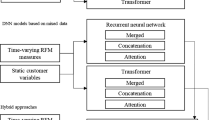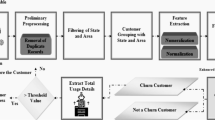Abstract
Retail companies are greatly interested in performing continuous monitoring of purchase traces of customers, to identify weak customers and take the necessary actions to improve customer satisfaction and ensure their revenues remain unaffected. In this paper, we formulate the customer churn prediction problem as a Predictive Process Monitoring (PPM) problem to be addressed under possible dynamic conditions of evolving retail data environments. To this aim, we propose TSUNAMI as a PPM approach to monitor the customer loyalty in the retail sector. It processes online the sale receipt stream produced by customers of a retail business company and learns a deep neural model to early detect possible purchase customer traces that will outcome in future churners. In addition, the proposed approach integrates a mechanism to detect concept drifts in customer purchase traces and adapts the deep neural model to concept drifts. Finally, to make decisions of customer purchase monitoring explainable to potential stakeholders, we analyse Shapley values of decisions, to explain which characteristics of the customer purchase traces are the most relevant for disentangling churners from non-churners and how these characteristics have possibly changed over time. Experiments with two benchmark retail data sets explore the effectiveness of the proposed approach.














Similar content being viewed by others
Data, Material, and/or Code Availability
Code that support the findings of this study and data extracted for training the classification algorithms are available at https://github.com/vinspdb/TSUNAMI.
Notes
Any accuracy metric can be used in this place.
As an additional constraint, let us consider that retails data are commonly recorded fro 18 months, hence serialized values of \(\textbf{T}\) older than 18 months can be also removed from the disk.
The source code is available online at https://github.com/vinspdb/TSUNAMI
References
Ahn, J., Hwang, J., Kim, D., et al. (2020). A survey on churn analysis in various business domains. IEEE Access, 8, 220816–220839. https://doi.org/10.1109/ACCESS.2020.3042657
Alippi, C., Boracchi, G., & Roveri, M. (2017). Hierarchical change-detection tests. IEEE Transactions on Neural Networks and Learning Systems, 28(2), 246–258. https://doi.org/10.1109/TNNLS.2015.2512714
Alippi, C., & Roveri, M. (2008). Just-in-time adaptive classifiers-part i: Detecting nonstationary changes. IEEE Transactions on Neural Networks, 19(7), 1145–1153. https://doi.org/10.1109/TNN.2008.2000082
Benczúr, A. A., Kocsis, L., & Pálovics, R. (2019). Encyclopedia of big data technologies, chap. Online machine learning algorithms over data streams (pp. 1199–1207). Springer International Publishing: Cham. https://doi.org/10.1007/978-3-319-77525-8_329
Bifet, A., & Gavaldà, R. (2007). Learning from time-changing data with adaptive windowing. In: 7th SIAM International conference on data mining, proceedings (pp. 443–448). SIAM. https://doi.org/10.1137/1.9781611972771.42
Bolton, R. N. (1998). A dynamic model of the duration of the customer’s relationship with a continuous service provider: The role of satisfaction. Marketing Science, 17(1), 45–65.
Brzezinski, D., Minku, L. L., Pewinski, T., et al. (2021). The impact of data difficulty factors on classification of imbalanced and concept drifting data streams. Knowledge and Information Systems, 63(6), 1429–1469. https://doi.org/10.1007/S10115-021-01560-W
Brzezinski, D., Stefanowski, J., Susmaga, R., et al. (2020). On the dynamics of classification measures for imbalanced and streaming data. IEEE Transactions on Neural Networks and Learning Systems, 31(8), 2868–2878. https://doi.org/10.1109/TNNLS.2019.2899061
Chen, Y., Xie, X., & Lin, S. D., et al. (2018). Wsdm cup 2018: Music recommendation and churn prediction. In: Proceedings of the Eleventh ACM International Conference on Web Search and Data Mining (pp. 8–9). ACM. https://doi.org/10.1145/3159652.3160605
Di Francescomarino, C., & Ghidini, C. (2022). Process mining handbook, chap. Predictive process monitoring (pp. 320–346). Springer International Publishing: Cham. https://doi.org/10.1007/978-3-031-08848-3_10
Ditzler, G., Roveri, M., Alippi, C., et al. (2015). Learning in nonstationary environments: A survey. IEEE Computational Intelligence Magazine, 10(4), 12–25. https://doi.org/10.1109/MCI.2015.2471196
Duan, Y., & Ras, Z. W. (2022). Recommendation system for improving churn rate based on action rules and sentiment mining. International Journal of Data Mining, Modelling and Management, 14(4), 287–308.
Fu, K., Zheng, G., & Xie, W. (2023). Customer churn prediction for a webcast platform via a voting-based ensemble learning model with nelder-mead optimizer. Journal of Intelligent Information Systems, 1–21
Galanti, R., de Leoni, M., Monaro, M., et al. (2023). An explainable decision support system for predictive process analytics. Engineering Applications of Artificial Intelligence, 120, 105904. https://doi.org/10.1016/j.engappai.2023.105904
Gama, J., Zliobaite, I., & Bifet, A., et al. (2014). A survey on concept drift adaptation. ACM Computing Surveys, 46(4), 44:1–44:37. https://doi.org/10.1145/2523813
Geiler, L., Affeldt, S., & Nadif, M. (2022). A survey on machine learning methods for churn prediction. International Journal of Data Science and Analytics, 14, 217–242. https://doi.org/10.1007/s41060-022-00312-5
Gobet, F., & Lane, P. C. R. (2012). Encyclopedia of the sciences of learning, chap. Chunking mechanisms and learning (pp. 541–544). Springer: US. https://doi.org/10.1007/978-1-4419-1428-6_1731
Günther, C. C., Tvete, I. F., Aas, K., et al. (2014). Modelling and predicting customer churn from an insurance company. Scandinavian Actuarial Journal, 2014(1), 58–71. https://doi.org/10.1080/03461238.2011.636502
Hoi, S. C., Sahoo, D., Lu, J., et al. (2021). Online learning: A comprehensive survey. Neurocomputing, 459, 249–289. https://doi.org/10.1016/j.neucom.2021.04.112
Jain, N., Tomar, A., & Jana, P. K. (2021). A novel scheme for employee churn problem using multi-attribute decision making approach and machine learning. Journal of Intelligent Information Systems, 56, 279–302.
Leung, C. K., Pazdor, A. G., & Souza, J. (2021). Explainable artificial intelligence for data science on customer churn. In: 2021 IEEE 8th International conference on data science and advanced analytics DSAA 2021 (pp. 1–10). https://doi.org/10.1109/DSAA53316.2021.9564166
Liu, Y., Fan, J., Zhang, J., et al. (2023). Research on telecom customer churn prediction based on ensemble learning. Journal of Intelligent Information Systems, 60(3), 759–775.
Lu, J., Liu, A., Dong, F., et al. (2019). Learning under concept drift: A review. IEEE Transactions on Knowledge and Data Engineering, 31(12), 2346–2363. https://doi.org/10.1109/TKDE.2018.2876857
Lundberg, S. M., & Lee, S. I. (2017). A unified approach to interpreting model predictions. In: Advances in Neural Information Processing Systems, vol. 30. Curran Associates, Inc.
Maisenbacher, M., & Weidlich, M. (2017). Handling concept drift in predictive process monitoring. In: IEEE International Conference on Services Computing, SCC 2017 (pp. 1–8). https://doi.org/10.1109/SCC.2017.10
Mena, G., Coussement, K., & Bock, K. W. D., et al. (2023). Exploiting time-varying rfm measures for customer churn prediction with deep neural networks. Annals of Operations Research. https://doi.org/10.1007/s10479-023-05259-9
Miguéis, V., Van den Poel, D., Camanho, A., et al. (2012). Modeling partial customer churn: On the value of first product-category purchase sequences. Expert Systems with Applications, 39(12), 11250–11256. https://doi.org/10.1016/j.eswa.2012.03.073
Mohammadzadeh, M., Hoseini, Z. Z., & Derafshi, H. (2017). A data mining approach for modeling churn behavior via rfm model in specialized clinics case study: A public sector hospital in tehran. In: International conference on theory and application of soft computing, computing with words and perception, ICSCCW 2017, vol. 120 (pp. 23–30). https://doi.org/10.1016/j.procs.2017.11.206
Murindanyi, S., Wycliff Mugalu, B., & Nakatumba-Nabende, J., et al. (2023). Interpretable machine learning for predicting customer churn in retail banking. In: International conference on trends in electronics and informatics ICOEI 2023 (pp. 967–974). https://doi.org/10.1109/ICOEI56765.2023.10125859
Muschalik, M., Fumagalli, F., & Hammer, B., et al. (2023). isage: An incremental version of SAGE for online explanation on data streams. In: D. Koutra, C. Plant, M.G. Rodriguez, et al. (Eds.), European Conference on machine learning and knowledge discovery in databases: research track, ECML PKDD 2023, proceedings, part III, lecture notes in computer science, vol. 14171 (pp. 428–445). Springer . https://doi.org/10.1007/978-3-031-43418-1_26
Pashami, S., Nowaczyk, S., & Fan, Y., et al. (2023). Explainable predictive maintenance. https://doi.org/10.48550/ARXIV.2306.05120. CoRR
Pasquadibisceglie, V., Appice, A., Castellano, G., et al. (2020). ORANGE: outcome-oriented predictive process monitoring based on image encoding and CNNs. IEEE Access, 8, 184073–184086. https://doi.org/10.1109/ACCESS.2020.3029323
Pasquadibisceglie, V., Appice, A., Castellano, G., et al. (2023). DARWIN: An online deep learning approach to handle concept drifts in predictive process monitoring. Engineering Applications of Artificial Intelligence, 123, 106461. https://doi.org/10.1016/j.engappai.2023.106461
Pauwels, S., & Calders, T. (2021). Incremental predictive process monitoring: The next activity case. In: Business process management, BPM 2021 (pp. 123–140). Springer International Publishing: Cham. https://doi.org/10.1007/978-3-030-85469-0_10
Prabadevi, B., Shalini, R., & Kavitha, B. (2023). Customer churning analysis using machine learning algorithms. International Journal of Intelligent Networks, 4, 145–154. https://doi.org/10.1016/j.ijin.2023.05.005
Read, J., & Zliobaite, I. (2022). Learning from data streams: An overview and update. In: CoRR, vol. abs/2212.14720. https://doi.org/10.48550/ARXIV.2212.14720
Sahoo, D., Pham, Q., & Lu, J., et al. (2018). Online deep learning: Learning deep neural networks on the fly. In: Proceedings of the 27th international joint conference on artificial intelligence, IJCAI 2018 (pp. 2660-2666). AAAI Press
Seymen, O. F., Dogan, O., & Hiziroglu, A. (2021). Customer churn prediction using deep learning. In: A. Abraham, Y. Ohsawa, N. Gandhi, M. Jabbar, A. Haqiq, S. McLoone, & B. Issac (Eds.), Proceedings of the 12th international conference on soft computing and pattern recognition, SoCPaR 2020, (pp. 520–529). Springer International Publishing: Cham. https://doi.org/10.1007/978-3-030-73689-7_50
Tan, C., Sun, F., & Kong, T., et al. (2018a). A survey on deep transfer learning. In: International conference on artificial neural networks and machine learning, ICANN 2018. https://doi.org/10.1007/978-3-030-01424-7_27
Tan, F., Wei, Z., & He, J., et al. (2018b). A blended deep learning approach for predicting user intended actions. In: 2018 IEEE International conference on data mining (ICDM) (pp. 487–496). https://doi.org/10.1109/ICDM.2018.00064
Teinemaa, I., Dumas, M., & La Rosa, M., et al. (2019). Outcome-oriented predictive process monitoring: Review and benchmark. ACM Transactions on Knowledge Discovery from Data, 13(2). https://doi.org/10.1145/3301300
Tekouabou, S. C. K., Gherghina, S. C., & Toulni, H., et al. (2022). Towards explainable machine learning for bank churn prediction using data balancing and ensemble-based methods. Mathematics, 10(14). https://doi.org/10.3390/math10142379
Van den Poel, D., & Larivière, B. (2004). Customer attrition analysis for financial services using proportional hazard models. European Journal of Operational Research, 157(1), 196–217. https://doi.org/10.1016/S0377-2217(03)00069-9
Vázquez-Martínez, U. J., Morales-Mediano, J., & Leal-Rodríguez, A. L. (2021). The impact of the covid-19 crisis on consumer purchasing motivation and behavior. European Research on Management and Business Economics, 27(3), 100166. https://doi.org/10.1016/j.iedeen.2021.100166
Webb, G. I., Lee, L. K., Goethals, B., et al. (2018). Analyzing concept drift and shift from sample data. Data Mining and Knowledge Discovery, 32(5), 1179–1199. https://doi.org/10.1007/S10618-018-0554-1
Zhao, P., Xie, Y., & Zhang, L., et al. (2022). Efficient methods for non-stationary online learning. In: 36th Conference on neural information processing systems, NeurIPS 2022 (pp. 1–13).
Zhong, Y., Zhou, J., Li, P., et al. (2023). Dynamically evolving deep neural networks with continuous online learning. Information Sciences, 646, 119411. https://doi.org/10.1016/j.ins.2023.119411
Acknowledgements
The work of Vincenzo Pasquadibisceglie was supported by the project FAIR - Future AI Research (PE00000013), Spoke 6 - Symbiotic AI, under the NRRP MUR program funded by the NextGenerationEU. The work of Annalisa Appice, Donato Malerba and Giuseppe Ieva was in partial fulfilment of the research objectives of the Research Contract “LUTECH DIGITALE 4.0: Progetto di Tecniche di Machine Learning predittivo per la piattaforma di loyalty Management” within the project “LUTECH DIGITALE 4.0”. We thank reviewers for useful suggestions provided to improve the manuscript.
Author information
Authors and Affiliations
Contributions
V. P.: Conceptualization, Methodology, Software, Validation, Investigation, Writing - original draft, Writing - review & editing A. A.: Conceptualization, Methodology, Validation, Investigation, Writing - original draft, Writing - review & editing, Supervision, Project administration. G. I.: Conceptualization, Investigation, Writing - review & editing. D. M.: Conceptualization, Methodology, Writing - original draft, Writing - review & editing
Corresponding author
Ethics declarations
Ethics Approval
We declare that this submission follows the policies as outlined in the Guide for Authors. The current research involves no Human Participants and/or Animals.
Conflict of Interests
The authors declare that they have no conflict of interest.
Competing Interests
The authors declare no competing interests.
Additional information
Publisher's Note
Springer Nature remains neutral with regard to jurisdictional claims in published maps and institutional affiliations.
Rights and permissions
Springer Nature or its licensor (e.g. a society or other partner) holds exclusive rights to this article under a publishing agreement with the author(s) or other rightsholder(s); author self-archiving of the accepted manuscript version of this article is solely governed by the terms of such publishing agreement and applicable law.
About this article
Cite this article
Pasquadibisceglie, V., Appice, A., Ieva, G. et al. TSUNAMI - an explainable PPM approach for customer churn prediction in evolving retail data environments. J Intell Inf Syst (2023). https://doi.org/10.1007/s10844-023-00838-5
Received:
Revised:
Accepted:
Published:
DOI: https://doi.org/10.1007/s10844-023-00838-5




